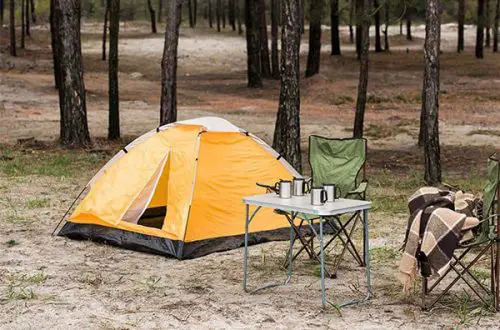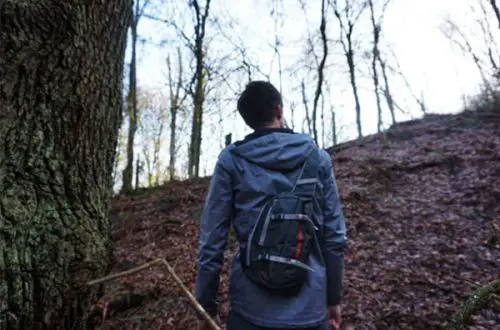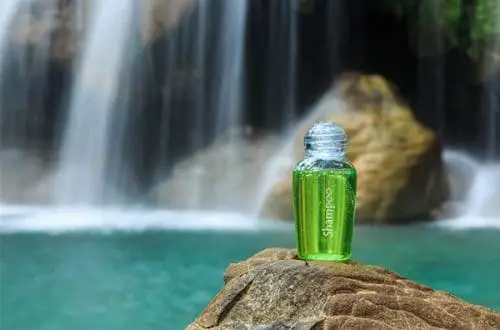The Definitive Buyers Guide: How to Choose Flashlights
Table of Contents
Most of us, when getting a flashlight, don’t really look at the specifications of it. Rather, what’s more important is that it produces light. But that’s not the only thing that we need to pay attention to when we’re looking for a flashlight. Whether you’re going to be camping, backpacking, or using it around the house, there’s a flashlight out there that will suit your specific needs.
Looking for other accessories? Check out these other popular camping gear:
Now, recently, headlamps have gained massive popularity among campers and backpackers, however, a flashlight is always a good option when you’re looking for a handheld light device. Naturally, there are a couple of reasons as to why flashlights are preferred:
- Signaling
- Placing the light down when you need to work
- When you need the strongest portable light source
- When you’re needing precision while controlling the light
With the advancement in technology and the increase of battery life, flashlights have now become more portable, lighter in weight, and even brighter. If you’re looking for an LED flashlight, then we’re going to show you everything there is to know about LED flashlights. That way, you choose the one that’s right for you.
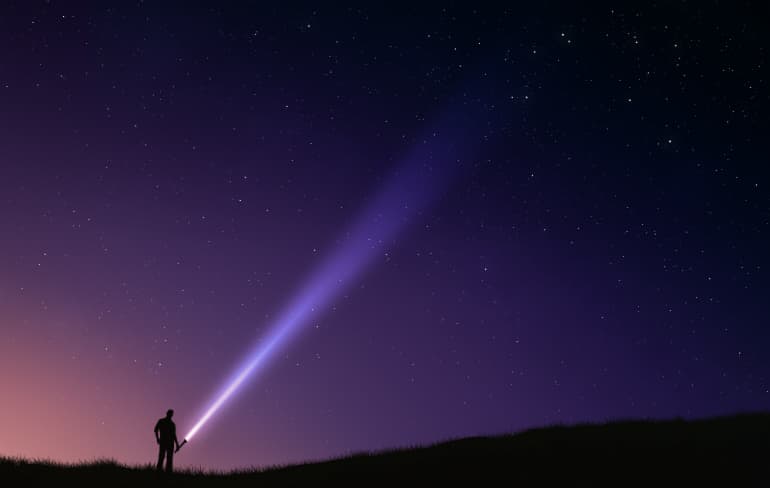
Why is it important to choose the right flashlight?
Now, you may be wondering, why do I even need a flashlight? What’s wrong with using the flashlight that’s on my phone? Well, a flashlight is a very important tool that many people overlook. You may think that a flashlight is a chunky and heavy tool to be lugging around with you – which was true maybe ten years ago.
Back in the day, if you wanted a brighter flashlight then you needed one that weighed at least 5 pounds. However, with the help of technology, now you can find a flashlight that weighs less than your car keys, yet produce light as bright as a 5-pound flashlight.
Naturally, flashlights are essential when you’re in the dark. Of course, if you’re at the movie theatre and need to find your seat, you don’t need to bring along a flashlight. Instead, your cell phone light will work perfectly fine. However, there are some cases where a flashlight is essential.
Camping/Backpacking
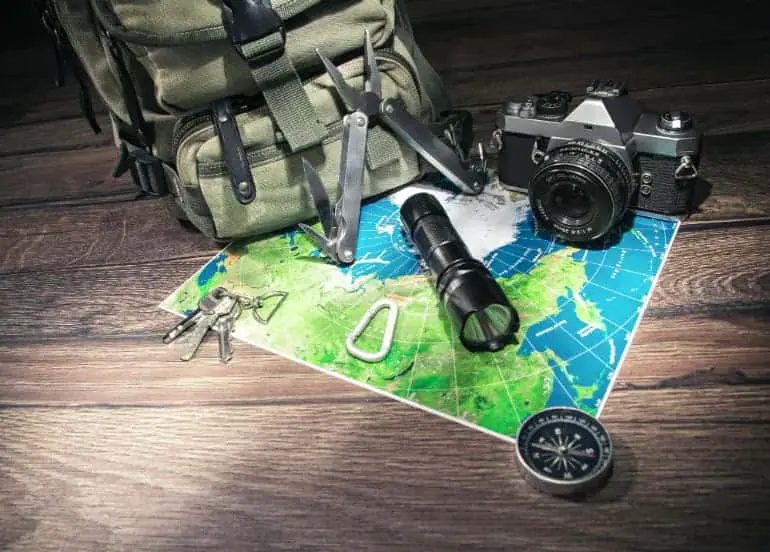
Of course, making a fire and having a lit torch or lantern is a fun way of creating your own light source, but having a flashlight available is a necessity. If it’s raining outside and you cannot use your lit lantern or torch, well, then you’re going to have to use an alternative light source. This is where a flashlight plays a crucial role.
Hunting
An LED light is ideal for hunters as they produced soft light, yet have a long run time. Typically, headlights are better options as then you’re given free use of both your hands. The LED lights also come in colors which are easier on your eyes and don’t frighten the game.
Emergency Use/Home Use
You always need a flashlight in your emergency kit and one sitting in your kitchen drawer. For flashlights used for home use, you don’t need to break the bank for this. A simple and cheap flashlight will work wonders if you need to fix the circuit breaker.
However, for your emergency kit, you should invest in an LED flashlight as they have a long run time which you may need. Whether the power goes out in your home or there’s a natural disaster, a flashlight can literally save your life.
Make sure that you check your flashlight on a yearly basis to make sure it’s working properly. Carry extra batteries or chargers if required for your flashlight. Also having a manual flashlight will come in handy if you run out of batteries. All you need to do is crank it up and it’s good to go.
Scuba Diving
When you’re scuba diving, depending on the time of day and the visibility of the water, you’re going to need a flashlight. Not only that, you’ll be needing a flashlight which is also waterproof and is able to withstand pressure. These specifications are always listed on the packaging of a flashlight.
Defence Against the Wild
When we think of flashlights, we rarely see them as self-defense tools, however, the flashlight has multiple uses. You have to acknowledge and understand that some tools that you carry can be used for other purposes outside of its main use.
Now, a flashlight, especially when you’re camping or backpacking, can be a great self-defense tool if you encounter a wild animal. You can use it to flash the light in their eyes in order to escape the situation. This is highly effective in giving you a couple extra seconds to get away. You do not have to come into physical contact either, simply shine the light and get away.
Spotting
There will be situations where you’re trying to find something, whether it’s on land or in water. In this case, you’re needing a flashlight which has the power and distance to scan over an area. For example, if there’s floating debris that’s harming your boat, you want to be able to see it. If you’re participating in a search and rescue, then you’re also going to need a strong and powerful light source. In these cases, a spotlight works wonders.
The fact is, there is always a chance of 100% darkness. Of course, we never think about it that way, but it’s true. You don’t need to go out into the wild in order to feel that there’s going to be 100% darkness. There could be a power outage in your city where everything goes completely black.
The point is, there’s always a chance where you may need a flashlight. Naturally, the points above are for some of the more common uses of a flashlight, however, ideally, you should be carrying a flashlight on you wherever you go.
Though you may be looking for a flashlight to accompany you while camping or backpacking, you should also consider getting a flashlight for everyday use – even though you may not need to use it on a daily basis. Don’t always rely on your cell phone as a light source, we all know how weak our cell phone batteries are at the end of the day.
Now that you know why it’s so important to carry a flashlight, it’s time you asked yourself some important questions to help you narrow down your search.
Questions to ask yourself
When shopping for a flashlight in person, there are a couple of questions you should ask yourself in order to choose the best flashlight for you. Naturally, you want to make sure that you’re choosing the right flashlight for your needs. All flashlights will produce light for you but not all of them are water resistant, for example:
- In order to change the battery, do you need a tool?
- Does it appear to suit your needs? For example, is it compact and lightweight enough? Or rugged enough?
- How does the light source switch on and off? Is there a possibility for it to accidentally turn on in your backpack? Will you be able to switch it off and on if you’re wearing gloves (if you’re going to use it in cold climates)?
- How does the flashlight feel in your hands?
Now that you know what you need to be asking yourself, it’s time you learned what features to pay attention to. That way, you can choose a flashlight that suits you and your needs.
Features to consider
Back in the day, centuries and centuries ago, we were using candles in order to light our way through the dark. However, through time, human beings discovered a way to store energy and emit light from bulbs, allowing us to get around with ease.
This breakthrough opened the path for us to improve on this idea and you can see the developments even throughout the past couple of years. Like I stated earlier, five years ago, if you wanted a bright light, your flashlight needed to weigh at least 5 pounds. But now, that same light is produced in a flashlight that weighs less than your car keys.
Now, these advancements led to the change in the size, weight, luminescence, and durability in flashlights. When deciding on a flashlight, you’ll need to first look at what you want out of your flashlight. Yes, you want light, but what else? Is weight a priority for you? What type of bulb do you want?
See, it’s not as simple as you thought. Asking yourself these questions is essential as not every flashlight is designed in the same way. In fact, there is a wide range of flashlights which serve different purposes. If you’re going to be backpacking, for example, then you’re looking for a lightweight and durable flashlight.
However, one thing is right. The second the sun goes down, we all need light. Now, all you need to figure out is which flashlight will work for you the best. You don’t want to be caught in the middle of the wilderness without light. So, these are some features you need to consider when looking at how to choose flashlights.
Durability
When it comes to camping and backpacking gear, you want a flashlight that’ll be able to take a beating during your trip. You’re going to drop it, it’s going to get kicked around, so durability is essential.
If you want a rugged flashlight for backpacking or camping, the best are ones that are designed with space-tech aluminum and graphite. These materials can be used in harsh weather conditions for years and still function perfectly. In addition, there are some flashlights that are also made of single block of aluminum which are also highly durable as well.
Making sure that your flashlight is constructed properly alleviates most of your worries when you’re backpacking or camping. You want a flashlight that’s shockproof, water-resistant, and crushproof. One thing to remember though, water resistance doesn’t mean waterproof.
You’ll be able to carry your flashlight in the rain and snow, however, you won’t be able to submerge it into the water. If you’re looking for a flashlight with that capability, then look for one which is waterproof.
Battery
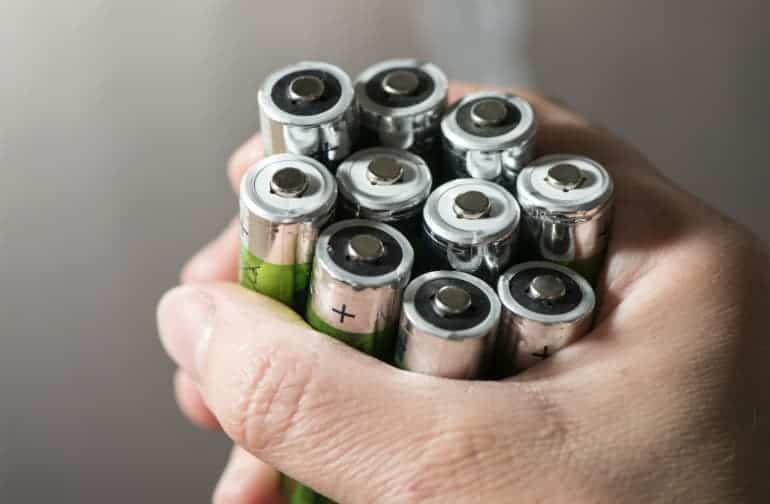
Of course, when selecting a flashlight, the battery is a very crucial component that you need to pay attention to. Now there are a couple of different types of batteries that are available on the market.
Disposable batteries
Disposable batteries come in two forms, either alkaline or lithium, with both having an excellent longevity of up to 10 years. Typically, these batteries offer longer run times and are usually cheaper and easier to carry around. However, their operating costs are usually more expensive in comparison to rechargeable batteries and they also don’t produce as much power, and therefore, light.
Lithium cell batteries have a high energy density but are more expensive than alkaline. In addition, lithium cell batteries also produce a constant voltage of up to 95% of their life. Whereas alkaline batteries drop their voltage at a higher rate, this is due to their composition. A modern composition like the one designed with lithium batteries have low internal resistance.
Rechargeable batteries
Rechargeable batteries have relatively low expenses when it comes to operating them. Though the initial cost of a rechargeable battery is higher, you end up saving a significant amount of money using it rather than a disposable battery. They’re great if you’re going to be using the flashlight on a regular basis. In addition, depending on the model, you may be provided with a custom charging holder.
Rechargeable USB
Now, you may need high-performance lights and it’s possible for you to have them. You can opt for rechargeable USB lithium-ion batteries. This battery is different than the others we’ve talked about. It provides users with an integrated charging port which is usable with any USB port. Though the initial cost of this battery is higher, you do save money over the long-run since you do not need to purchase new batteries.
Renewable
These are flashlights which come with a built-in battery energizer. You’ll either need to power it by using a hand crank or a solar panel. These are ideal emergency flashlights as you’re not dependant on batteries to use it.
Choosing the right battery is essential, however, there’s no wrong decision. It’s simply based on your needs. Whether it’s an alkaline or lithium battery, you just need to make sure that it does what you need it to do.
Size and weight
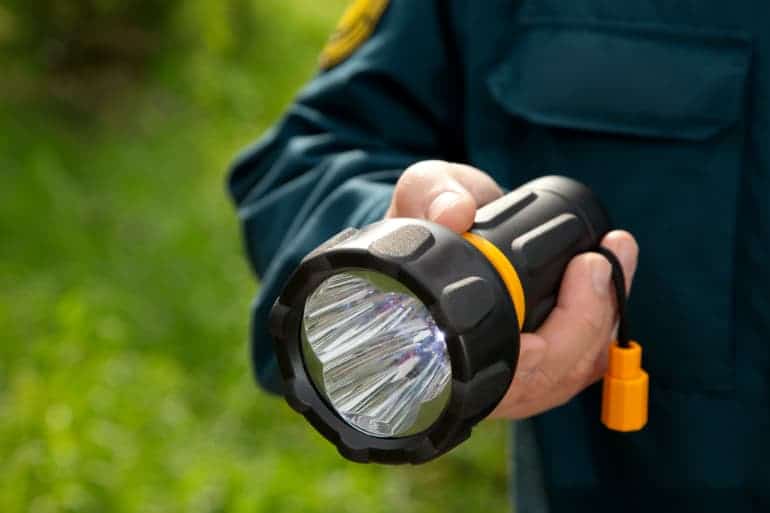
Naturally, there are a variety of different flashlights on the market, all coming in different sizes and weights for a reason. Not all flashlights are being used for the same purpose, thus, you need a proper selection of varying flashlights. There are flashlights that can attach to your keychain, or you may prefer a larger flashlight. Like I said before, you need a flashlight that suits your needs.
Now, for backpacking and camping, the most popular flashlight is a regular-size flashlight. They usually range anywhere between 4 to 6 inches in length which is ideal because it can easily fit in the palm of your hand but won’t be too bulky either. If you’re going to be backpacking or camping, you’ll want a flashlight that’s as lightweight as possible. If you need a flashlight for rugged use, opt for one that weighs around 4 ounces. But, of course, there are lighter options available as well.
Bulb type
Back in the day, you were able to purchase a variety of different types of bulbs including halogen and xenon. However, as technology evolved, most of the flashlights on the market are now designed with LED lights. Though, you still have a couple of other options when it comes to light bulbs. Let’s go through the different types of bulbs that are available.
Incandescent bulbs
An incandescent bulb is designed using a thin filament that passes current through it. Once the filament becomes hot, it causes it to glow, creating light. The glass surrounding it prevents oxygen from passing through and destroying the filament. There are specific gasses such as xenon and halogen which increase the temperature, making the bulb shine brighter. This also increases the life of the filament as well.
Though, these light bulbs are generally not very durable nor are they shockproof either. However, they do produce a bright white light. These light bulbs produce an extremely strong beam and are ideal for long distances, thus, if you’re needing a flashlight for highly lit situations, then this is a great option. However, if you need a flashlight for more rugged adventures, then this is not a good choice for you.
LEDs
Currently on the market, LEDs are the most popular light bulb. LEDs, light emitting diodes, have a solid construction and are known to be highly durable. They have an extremely long lifespan, producing up to 100,000 hours of light before needing a replacement.
This is ideal if you’re looking for a light source that won’t need constant checking up on nor will it require you to constantly spend money on replacement bulbs. They have a soft glow which is ideal for close up viewing. Though they’re not as powerful as incandescent light bulbs, they are extremely powerful and have run times consisting of hundreds of hours. Ideally, they’re great for outdoor use and rugged situations.
HIDs
This bulb uses a compartment of metal vapor rather than a filament to produce light. The HIDs, high-intensity discharge bulbs, are extremely bright, brighter than your regular incandescent bulbs, however, require a ballast to control the current. These bulbs are long-lasting and have a lifespan that’s double the incandescent bulb. Plus, they produce brighter light and use less power.
Beam Type
Surrounding the bulb, you have a lens reflector which directs how the light will be dispersed. The way the light is dispersed can dramatically change the way your flashlight can be used. There are three common options you have when it comes light dispersion. They are:
Flood or fixed
This form of light dispersion is a single beam width. This is typically ideal for general use such as camping or to use while walking.
Spot or focused
This is a single beam which is minimized into a spotlight. The purpose is to create light which can be used for long distances. If you’re trying to find your route, you would use a spot/focused beam.
Adjustable
The beam type is adjustable to provide you with either a focused, fixed or in-between beam width. For example, if you’re wanting to use your flashlight to pitch a tent, you would most likely use a focused beam. However, if you want to check out your map, then you would most likely use a fixed beam.
Beam Colors
Depending on what you’re using your flashlight for, beam colors may or may not be of interest to you. Colored LEDs have become increasingly popular with hunters. If you’re a hunter, then colored LED lights may help you out. Green light is designed to not frighten the game, red is easy on human eyes, and blue is designed to track blood.
These are also known as lens filter and depending on the company may or may not be included with the flashlight. If they’re not included, you’ll have to purchase them separately. However, if you’re only planning on using your flashlight for everyday use, backpacking or camping, then a white light will work just fine.
Brightness
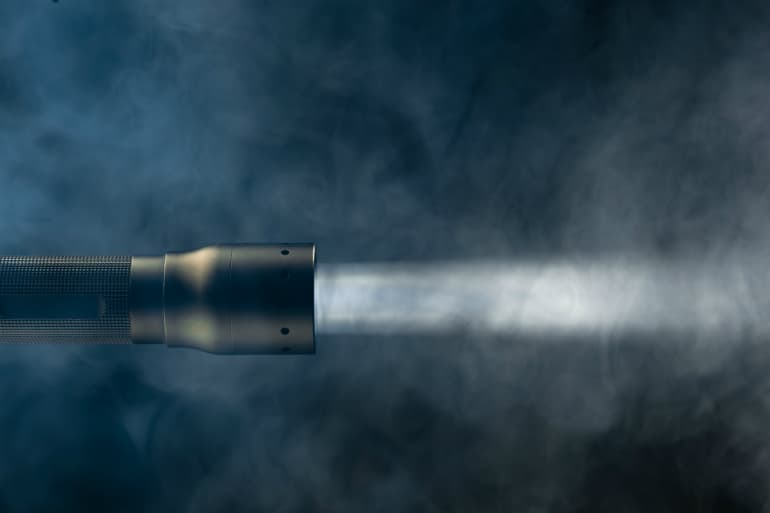
You may hear the terms “candlepower” or “peak beam candlepower” which is the measurement of the brightest spot in the beam. When measuring a lumen, you’re measuring all visible light. Now, the best way to develop an idea of the lumens a flashlight may have is to look at the numbers. The manufacturer of the flashlight will typically have the lumens listed on the packaging, however, if not, you should be able to find it on their website or on a review. Though, the only way to truly get a sense of the power of a lumen is to test it out yourself with a couple of different flashlights.
For example, a keychain flashlight may be listed as having 1 lumen. A penlight may have 45 lumens which is enough to prepare dinner at your campsite. However, that light won’t be able to be used for distances. In a regular flashlight, it can produce as little as 6 lumens and increase from there. For the brightest flashlight, one that can be seen from 120 meters away, you’ll need a flashlight that produces between 150 to 160 lumens.
See, it all depends on the purpose of your flashlight as that will help you decide on the brightness you’ll be needing. If your light isn’t bright enough, then you won’t be happy while using it and it’ll cause you more hassle, if anything.
Other features to consider
There are a couple of additional features that will also affect the flashlight you decide on. Though these may not be essential factors, they do make a difference when you’re using your flashlight.
Modes
There are some flashlights which offer users a single mode and then there are some which offer users 2 or 3 different modes. Now, for general use, you really only need to have a single setting. However, if you’re going to be using your flashlight for a variety of activities then having multiple modes is a nice feature to have.
Multiple modes typically include low, medium, high, and strobe light. Though you may never use all of these modes, having them available to you is always a nice feature. If you’re going to be camping or backpacking, a strobe or SOS mode is essential. Though, it’s important to remember that the brighter the mode is, the shorter the runtime.
Some flashlights also offer users the ability to program their own modes. This may be done directly on the flashlight or through an app or software that you connect via USB cable.
Controls
Most of us never think about the functionality of flashlight controls, however, depending on what you’re going to be using your flashlight for, the type of on/off switch and lighting modes may be important to you. If the switches are designed with buttons and sliders, then this is typically designed for thumb use. If the flashlight comes with a rotating bezel as a switch, then it’ll require 2 hands to operate it.
Look for a flashlight that has a safety lock feature, especially if you’re going to be camping or backpacking. The last thing you want is your battery to run out because it’s been accidentally turned on while inside your backpack. This could cause way more problems than you think.
Lastly, there are some flashlights which offer non-clicking controls, allowing you to switch it on or off with one click without having to cycle through the modes.
Accessories
If you want a couple of extra gadgets with your flashlight, you’re more than welcome to fully load your flashlight. Some of the accessories for your flashlight include a lanyard, lens filter, diffusers, or a belt clip. Now, these accessories aren’t a necessity, however, can be a nice addition to your flashlight. These add-ons may be included, depending on the company, or may require you to purchase them separately.
Flashlight Performance
In 2009, ANSI FL1 standards for flashlights were implemented which ensure that all models are tested and rated under one standard. Naturally, it is voluntary for companies do use this standard and many test their products on their own, however, large name companies display this performance data on their packaging to inform the customer on the level of product they’re considering to purchase. Here are the types of performance data which are included on the packaging of flashlights.
Light Output
The light output is measured in lumens. This measures the intensity of light that’s produced from the flashlight during the brightest setting on a set of new batteries. It may also list the light output for other light settings as well. Though it’s a great source of information, it doesn’t reveal the full story about the brightness of the flashlight. Beam intensity and distance also affect the light output, so, this is something to keep in mind as well. A light output can vary from 20 lumens to 3500 lumens.
Water Resistance
Water resistance is rated using the IPX system. This system rates how protected an item is from water or dust. The higher the number means the better protection against these elements. If you’re going to be using your flashlight outdoors, you’re susceptible to rain and debris. There are two ratings which are used:
- FL1 Standard with an icon of a rain cloud: indicates that the item has an IPX4 rating. This means that it’s splash resistant regardless of the angle.
- FL1 Standard with an icon of an arrow pointing below water: indicates a water submersion rating which will also state the meters the item can reach without receiving damage.
- IPX7: temporary submersion of up to 30 minutes reaching 1 meter in depth.
- IPX8: submersion of up to 4 hours. The depth varies depending on the company and will be specified.
Beam Distance
The beam distance is measured in meters. This test is to measure how far a light will shine before the brightness reduces to the light formed by a full moon. Full moon illumination is labelled as safe for travelling outdoors. Now, depending on the brightness settings, the distance will vary.
Run Time
The run time is measured in hours and is based on how long it takes the light output to drop to 10% of the rated output on new batteries. It’s rounded to the nearest quarter hour. The light output may slowly decrease over time or it may produce a constant light output and then drastically decrease. There’s usually a run time for each light setting. You may be given a run time graph which will illustrate the findings of the flashlights performance.
Impact Resistance
The impact resistance is measured in meters. What happens is that the lights are tested by dropping them on concrete at a rated distance. This happens six times to every flashlight. This test is to verify that the flashlight remains functional even after being accidentally dropped. However, this test doesn’t include if the flashlight has been run over or hit with a heavy object.
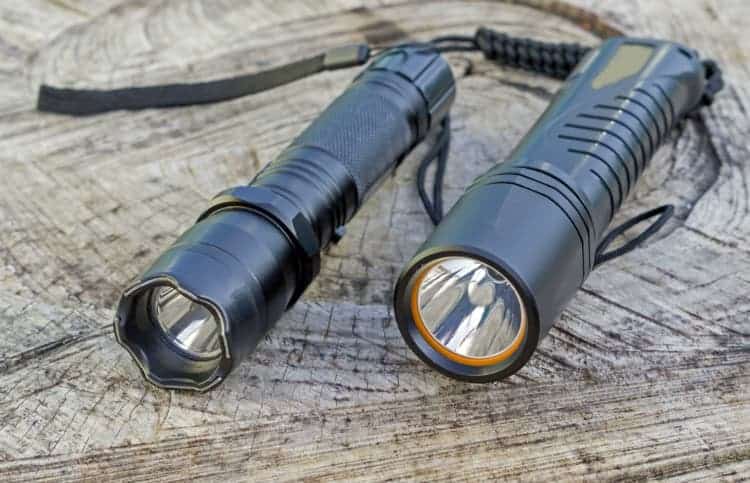
Conclusion
Who thought choosing a flashlight would contain so many elements? But, it’s really not as complex as it sounds. Firstly, what you need to do is decide on what you’re needing your flashlight for and what elements your flashlight may encounter. Once you have that determined, the rest is simply based off of preferences.
Remember, if you can’t decide, opting for a multi-purpose flashlight isn’t a bad choice. That way, you have a little bit of everything. Though, if you’re in need of a flashlight that serves a specific purpose, then take your time in finding the right one. Though it may seem like just a flashlight, it’s an essential tool that you’re going to be using much more than you originally thought. Go to the store and test some flashlights out.
Though we broke down everything in this guide, it may seem like a lot to take in. However, the best way to understand this guide is to head to a store and take a look at some flashlights. That way, you’ll be able to apply this information to a flashlight that’s in your hands.


